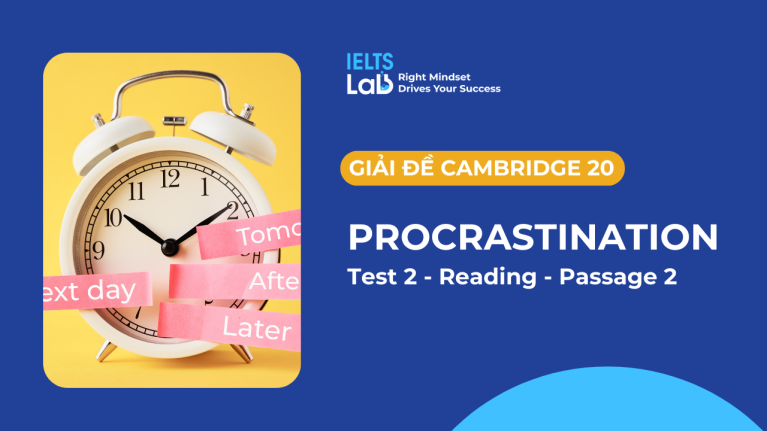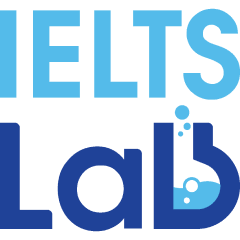Để cải thiện kỹ năng đọc nhằm chuẩn bị tốt cho kỳ thi IELTS, các bạn hãy luyện tập qua Cambridge IELTS 20 – Test 2: Reading Passage 2 – Procrastination nhé!

A. Đáp án
| Câu 14: B |
Câu 18: anxious | Câu 22: guilt | Câu 26: E |
| Câu 15: F | Câu 19: threats | Câu 23: A | |
| Câu 16: B | Câu 20: exams | Câu 24: C | |
| Câu 17: laziness | Câu 21: perfectionists | Câu 25: A |
B. Giải thích đáp án đề Cam IELTS 20, Test 2, Reading Passage 2
| Câu hỏi + Đáp án | Bài đọc |
| Câu 14: mention of false assumptions about why people procrastinate
=> Đáp án: B Nội dung câu hỏi là: Đề cập đến những giả định sai lầm // về lý do tại sao mọi người trì hoãn. Vế đầu “mention of false assumptions” được nhắc đến trong cụm: “contrary to popular belief” (trái với các quan niệm phổ biến). Vế sau “why people procrastinate” được nhắc đến trong bài ở câu “is … due to laziness or poor time management”. Thông tin nói rằng, quan niệm phổ biến là mọi người procrastinate là do lười hoặc quản lý thời gian kém là quan niệm sai lầm. |
Thông tin dòng 1-2 đoạn B
Contrary to popular belief, procrastination is not due to laziness or poor time management. Scientific studies suggest procrastination is, in fact, caused by poor mood management. |
Câu 15: reference to the realisation that others also procrastinate
Nội dung câu hỏi là: Nhắc đến việc nhận ra rằng người khác cũng trì hoãn. Nội dung “realisation that others also procrastinate” được nhắc đến ở đoạn F: Chúng ta nên nhắc nhở bản thân rằng chúng ta không phải người đầu tiên hay người cuối cùng trì hoãn. |
Thông tin dòng 9-10 đoạn F
We should remind ourselves that we’re not the first person to procrastinate, nor the last. |
Câu 16: neurological evidence of a link between procrastination and emotion
Nội dung câu hỏi là: Bằng chứng thần kinh học về mối liên hệ giữa sự trì hoãn và cảm xúc. Nội dung “neurological evidence” được nhắc đến ở dòng 6: “research involving brain imaging has found that areas of the brain linked to detection of threats and emotion regulation” (Nghiên cứu sử dụng phương pháp chụp não đã phát hiện rằng các vùng não liên quan đến việc phát hiện mối đe dọa và điều chỉnh cảm xúc thực sự khác biệt ở những người thường xuyên trì hoãn so với những người ít khi trì hoãn.) |
Thông tin dòng 6-9 đoạn B
Research involving brain imaging has found that areas of the brain linked to detection of threats and emotion regulation are actually different in people who chronically procrastinate compared to those who don’t procrastinate frequently.
|
Câu 17: Many people think that procrastination is the result of … . Others believe it to be the result of an inability to organise time efficiently.
Từ cần điền là một danh từ. So sánh paraphrase “many people think = popular belief”, “the result of = due to”, “inability to organise time efficiently = poor time management”. Lí do còn lại là “laziness”. |
Thông tin dòng 1 đoạn B
Contrary to popular belief, procrastination is not due to laziness or poor time management. |
Câu 18: The tasks we are most likely to put off are those that could damage our self-esteem or cause us to feel … when we think about them.
Từ cần điền là một tính từ chỉ cảm xúc. So sánh paraphrase: “we are most likely to put off = we will be more likely to put it off”, “the tasks … those that could damage our self-esteem = the task threatens our sense of self-worth” (những công việc mà đe dọa đến lòng tự trọng của chúng ta). Thông tin còn lại là “makes us anxious” có tính từ “anxious” là từ cần điền. |
Thông tin dòng 3-5 đoạn B
If just thinking about the task threatens our sense of self-worth or makes us anxious, we will be more likely to put it off. |
| Câu 19: Research comparing chronic procrastinators with other people even found differences in the brain regions associated with regulating emotions and identifying …
=> Đáp án: threats Từ cần điền là một danh từ. So sánh paraphrase: “chronic procrastinators = people who chronically procrastinate”, “other people = those who don’t procrastinate frequently”, “regulating emotions = emotion regulation”, “ identifying = detection of …”. |
Thông tin dòng 6-8 đoạn B
Research involving brain imaging has found that areas of the brain linked to detection of threats and emotion regulation are actually different in people who chronically procrastinate compared to those who don’t procrastinate frequently.
|
Câu 20: Emotionally loaded and difficult tasks often cause us to procrastinate. Getting ready to take … might be a typical example of one such task.
Từ cần điền là một danh từ. So sánh paraphrase: “Emotionally loaded and difficult tasks = Tasks that are emotionally loaded or difficult”, “a typical example = prime candidates for procrastination”, “getting ready to take = preparing for …”. |
Thông tin dòng 1 đoạn C.
Tasks that are emotionally loaded or difficult, such as preparing for exams, are prime candidates for procrastination. |
Câu 21: People who are likely to procrastinate tend to be either … or those with low self-esteem.
Nội dung câu hỏi: Những người dễ trì hoãn thường là những người … hoặc những người có lòng tự trọng thấp. Từ cần điền là một danh từ chỉ người. So sánh paraphrase: “low self-esteem” được giữ nguyên, Nhóm người còn lại là “perfectionists” – người theo chủ nghĩa hoàn hảo. |
Thông tin dòng 2-3 đoạn C
People with low self-esteem are more likely to procrastinate. Another group of people who tend to procrastinate are perfectionists, who worry their work will be judged harshly by others. |
Câu 22: Procrastination is only a short-term measure for managing emotions. It’s often followed by a feeling of …, which worsens our mood and leads to more procrastination.
Từ cần điền là một danh từ chỉ cảm xúc. So sánh paraphrase: “short-term measure for managing emotions = ‘mood repair’ we experience is temporary”, “worsens our mood and leads to more procrastination = increases their negative mood … reinforces their tendency to procrastinate” (gia tăng tâm trạng tiêu cực … củng cố xu hướng trì hoãn), “followed by … = afterwards, … tend to be left with …”. |
Thông tin câu cuối đoạn C
The ‘mood repair’ we experience is temporary. Afterwards, people tend to be left with a sense of guilt that not only increases their negative mood, but also reinforces their tendency to procrastinate. |
| Câu 23-24: Đáp án: A-C
Nội dung câu hỏi: Hai so sánh nào dưới đây giữa nhân viên hay trì hoãn và những người không trì hoãn được đề cập trong đoạn văn? A. Mức lương của họ thấp hơn. => Được nhắc đến trong bài ở câu “less annual income” (thu nhập hàng năm thấp hơn). Chọn A. C. Họ không giữ được việc lâu dài. => Được nhắc đến trong bài ở câu “less employment stability” (sự ổn định nghề nghiệp thấp hơn). Chọn C. |
Thông tin đoạn D
In fact, in one US survey of over 22,000 employees, participants who said they regularly procrastinated hadless annual income and less employment stability. |
| Câu 25-26: Đáp án: A-E
Nội dung câu hỏi: Tác giả đưa ra HAI đề xuất nào để thoát khỏi vòng luẩn quẩn của sự trì hoãn? A. Không phán xét bản thân quá khắt khe. => Được nhắc đến trong bài ở câu: “Forgiving ourselves … not be overly critical of ourselves” (Tha thứ cho bản thân, cảm thông với bản thân … không quá phán xét về barnthana). Chọn A. E. Tránh những điều khiến chúng ta mất tập trung vào công việc. => Được nhắc đến trong bài: “There are a number of evidence-based strategies that can help us fend off distractions” (Có một số chiến thuật với bằng chứng rõ ràng có thể giúp chúng ta tránh những thứ làm phân tâm). Chọn E. |
Thông tin ở đoạn F
There are a number of evidence-based strategies that can help us fend off distractions … Forgiving ourselves and feeling compassion when we procrastinate can help break the procrastination cycle. We should admit that we feel bad, but not be overly critical of ourselves. |
Trên đây là toàn bộ giải thích đáp án cho đề Cambridge IELTS 20, Test 2, Reading Passage 2: Procrastination được biên soạn bởi đội ngũ học thuật của IELTS Lab. Chúc các bạn học tốt!
>> Đọc thêm:https://ieltslab.edu.vn/cach-lam-dang-bai-matching-infomation-trong-ielts-reading/


















Trả lời